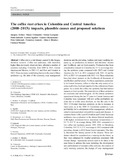| dc.description.abstract | Coffee rust is a leaf disease caused by the fungus,
Hemileia vastatrix. Coffee rust epidemics, with intensities
higher than previously observed, have affected a number of
countries including: Colombia, from 2008 to 2011; Central
America and Mexico, in 2012–13; and Peru and Ecuador in
2013. There are many contributing factors to the onset of these
epidemics e.g. the state of the economy, crop management
decisions and the prevailing weather, and many resulting impacts
e.g. on production, on farmers’ and labourers’ income
and livelihood, and on food security. Production has been
considerably reduced in Colombia (by 31 % on average during
the epidemic years compared with 2007) and Central
America (by 16 % in 2013 compared with 2011–12 and by
10 % in 2013–14 compared with 2012–13). These reductions
have had direct impacts on the livelihoods of thousands of
smallholders and harvesters. For these populations, particularly
in Central America, coffee is often the only source of income
used to buy food and supplies for the cultivation of basic
grains. As a result, the coffee rust epidemic has had indirect
impacts on food security. The main drivers of these epidemics
are economic and meteorological. All the intense epidemics
experienced during the last 37 years in Central America and
Colombia were concurrent with low coffee profitability periods
due to coffee price declines, as was the case in the
2012–13 Central American epidemic, or due to increases in
input costs, as in the 2008–11 Colombian epidemics. Low
profitability led to suboptimal coffee management, which resulted
in increased plant vulnerability to pests and diseases. A
common factor in the recent Colombian and CentralAmerican
epidemics was a reduction in the diurnal thermal amplitude,
with higher minimum/lower maximum temperatures (+
0.1 °C/-0.5 °C on average during 2008–2011 compared to a
low coffee rust incidence period, 1991–1994, in Chinchiná,
Colombia; +0.9 °C/-1.2 °C on average in 2012 compared with
prevailing climate, in 1224 farms from Guatemala). This likely
decreased the latency period of the disease. These epidemics
should be considered as a warning for the future, as
they were enhanced by weather conditions consistent with
climate change. Appropriate actions need to be taken in the
near future to address this issue including: the development
and establishment of resistant coffee cultivars; the creation of
early warning systems; the design of crop management systems adapted to climate change and to pest and disease
threats; and socio-economic solutions such as training and
organisational strengthening | es_ES |


